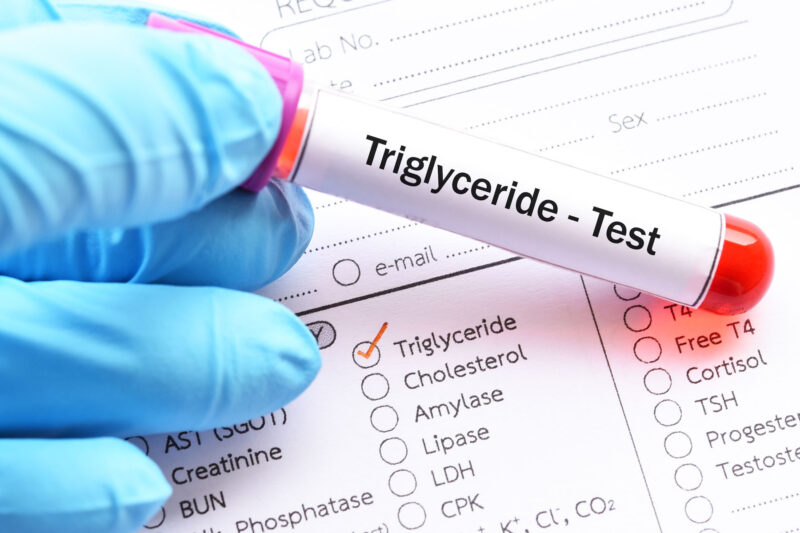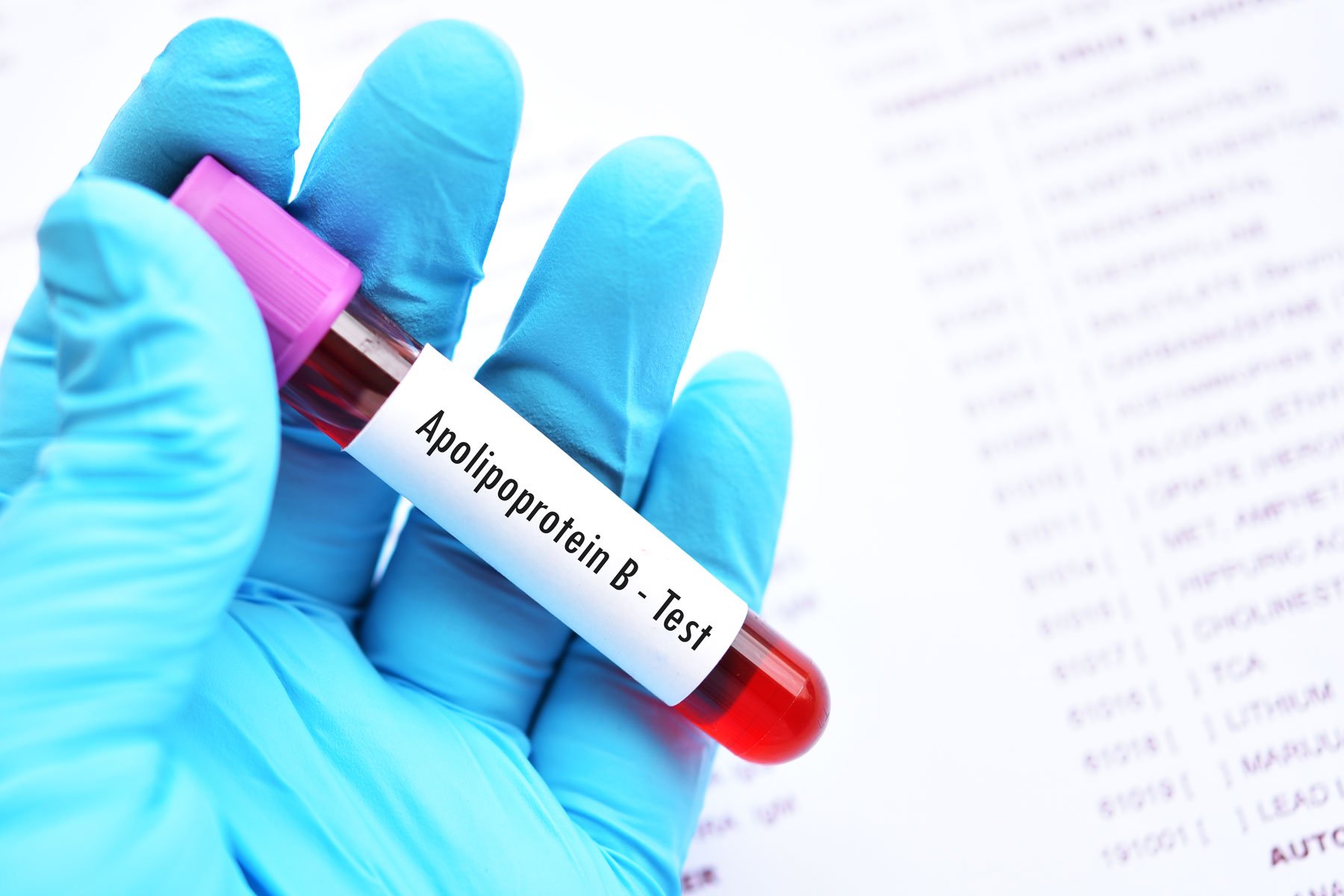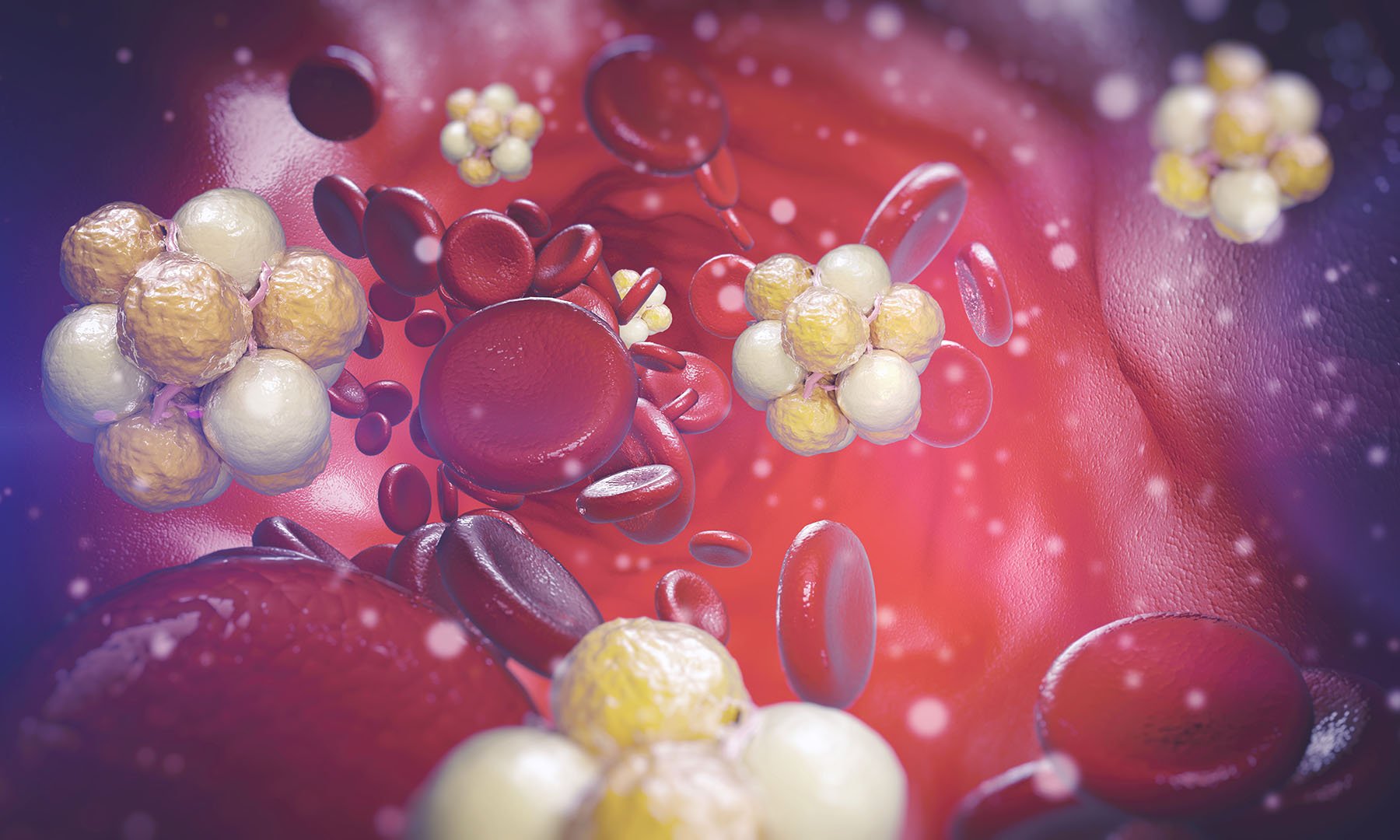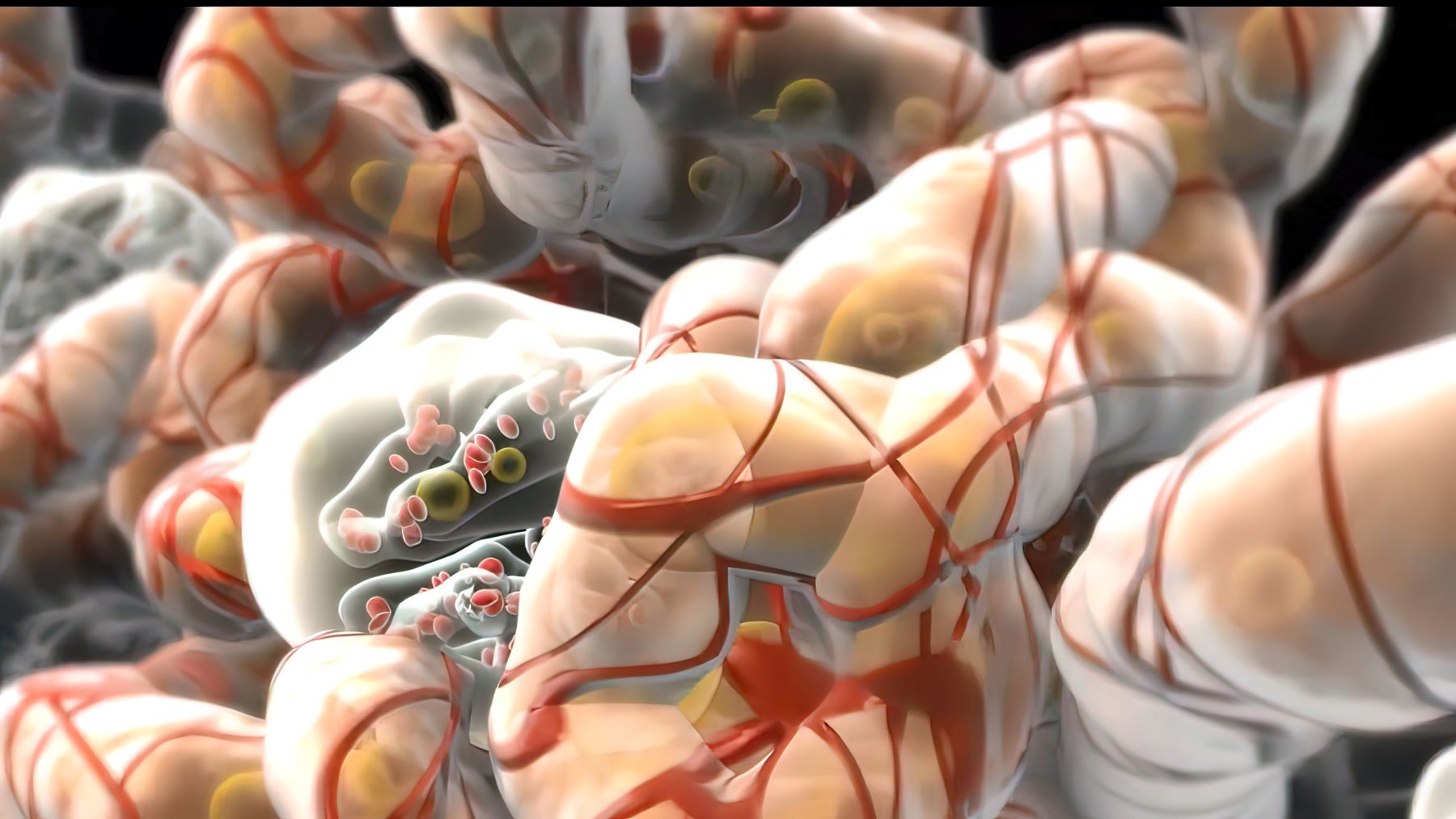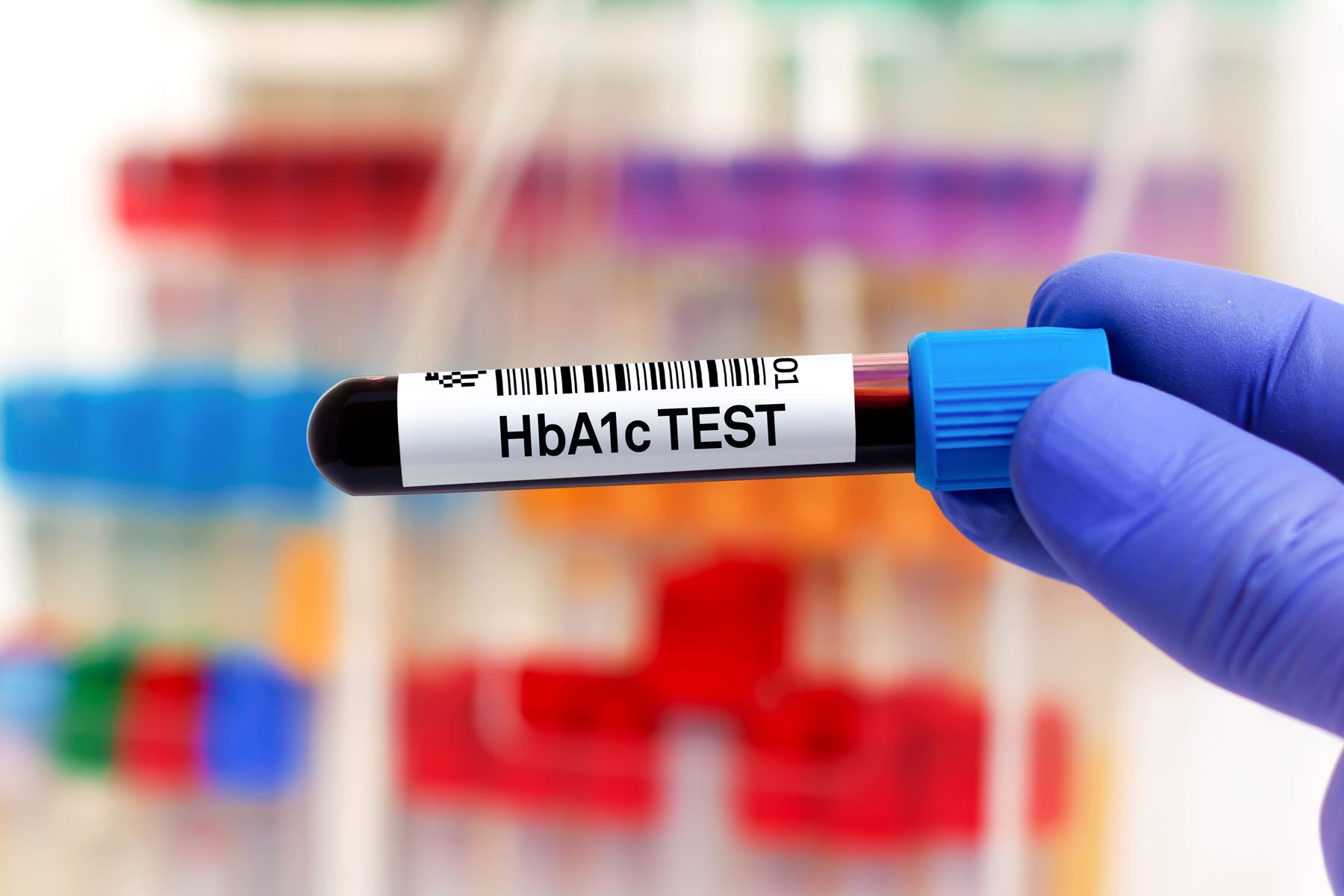Triglycerides are a type of fat the body uses to store and transport energy. And while they’re often lumped in with cholesterol, triglycerides are a unique lipid with major implications for your health.
Your body builds triglycerides from both internal and external sources. The external pathway begins in your intestines when you eat dietary fatty acids (like those found in plant and animal oils). Fatty acids are an important energy source for your body. To store them more efficiently, your intestine packages them into larger molecules made of three fatty acids attached to a single glycerol molecule (hence the name tri-glyceride). The triglyceride is then wrapped up alongside cholesterol into a particle called a chylomicron, which is effectively a vehicle that can travel easily through your bloodstream. Chylomicrons circulate until they find an available receptor in your muscle or fat tissue.
When a circulating chylomicron binds to a muscle cell, its triglycerides are released and broken back down into glycerol and fatty acids, which the cell absorbs. The cell can then burn these fatty acids for immediate energy. A similar process occurs when the chylomicron binds to a fat cell—but instead of using the fatty acids immediately, the cell rebuilds them into a triglyceride for long-term energy storage. Depleted of triglycerides, the chylomicron remnant returns to the liver and deposits its cholesterol.
In the internal path, triglycerides are synthesized in the liver from internal fatty acids. These fatty acids originate from two sources: A) the liver, which creates them from glucose in your bloodstream, and B) fat cells, which break down their triglycerides into fatty acids and release them into your bloodstream to supply your muscles with energy. This process of internal triglyceride synthesis is called de novo lipogenesis.
The liver packages up these new triglycerides along with cholesterol into a particle called a very low-density lipoprotein (VLDL). Like a chylomicron, VLDL is designed to travel easily through the bloodstream. It binds to your heart and skeletal muscles or to your fat tissue, where its triglycerides are burned for immediate energy or stored for later use, respectively. Having lost its triglycerides, the VLDL particle is smaller and denser; it is now an intermediate-density lipoprotein (IDL) containing mostly cholesterol. The IDL returns to the liver, where its remaining triglycerides are removed, converting it into a cholesterol-heavy low-density lipoprotein (LDL).
Although triglycerides and cholesterol are chemically similar (they’re both lipids), they serve very different purposes. Triglycerides are used for energy transportation and storage, while cholesterol is a building block for cells and hormones.
How do triglycerides impact metabolic health?
Triglycerides play an essential role in your daily metabolic functions. They allow your body to bundle up a raw energy source (fatty acids) into an easily unlocked form. But when your triglyceride levels run too high (aka hypertriglyceridemia), they are a danger to your metabolic health. Historically, this risk was difficult to quantify because triglyceride elevation tends to occur alongside other known risk factors (such as high LDL and low HDL cholesterol). But recent research has made the relationship clear: high triglycerides are a danger in their own right.
For instance, a 2021 study of 1283 people found that those with high triglycerides were 53% more likely to have heart attacks and other cardiac events—even after controlling for other risk factors. Another study from 2020 analyzed 158,042 people over 5 years and found that high triglycerides were linked to both heart disease and all-cause mortality. This relationship was stepwise: The higher the triglycerides, the greater the risk. High triglyceride levels are also associated with several other metabolic illnesses and risk factors, including obesity, insulin resistance, hypertension, and Type 2 diabetes.
Triglyceride elevation is caused by genetic and lifestyle factors, with diet playing a key role. That’s why standard medical guidance for hypertriglyceridemia is to lower carbohydrate intake—especially processed carbs and sugar-sweetened beverages—as well as saturated fat and alcohol. Simply substituting low-glycemic foods for high-glycemic ones can reduce triglyceride levels by 15-25 percent. To understand this effect, we need to explore how carbohydrates are processed and metabolized.
When you eat carbohydrates, they are broken down by your intestines into glucose—a simple sugar that powers your cells. This glucose travels to your liver, where it is either released into the bloodstream or stored on-site in a condensed form called glycogen. Any excess glucose is used to build fatty acids, which are either directly released into the bloodstream or packaged into triglyceride molecules and released as VLDL particles. This means a direct relationship exists between your carbohydrate intake and triglyceride levels. More carbs means more glucose, which means more fatty acids and, ultimately, more triglycerides in your blood.
There is also evidence that the kind of carbohydrates you eat can influence your triglyceride levels. When you eat simple, easily-digested sugars, your intestines secrete more chylomicrons, pumping more triglycerides into your bloodstream. And when your liver is exposed to simple sugars, it packs more triglycerides into each VLDL particle. This increases the total mass of triglycerides in your bloodstream. Diets with a higher glycemic load and higher glycemic index have been linked to elevated blood triglycerides in 9 major studies.
As we mentioned above, high triglycerides can directly cause disease. This process begins when triglyceride-heavy VLDL particles enter the wall of your arteries and become trapped. Their cholesterol and triglyceride cargo remains lodged in the arterial wall, kicking off (or contributing to) an inflammatory process that can ultimately develop into the atherosclerotic plaques that cause heart attacks and strokes. The presence of triglycerides in your arterial walls also triggers the production of cytokines—proteins that bring your body into an inflammatory state. Additionally, it contributes to the dysfunction of your blood vessels, which can worsen blood pressure and accelerate heart disease.
High triglycerides also negatively affect other blood lipids and lipid-carrying particles—particularly high-density lipoprotein (HDL). HDL (sometimes called the “good cholesterol”) protects against heart disease by removing cholesterol deposits from the arteries, effectively reversing the atherogenic process described above. People with high HDL are thus at low risk of heart disease, and vice versa. When HDL particles encounter triglyceride-bearing VLDL, the two sides swap cargo. HDL gives away its cholesterol and receives triglycerides in exchange. The HDL particle—now heavy with triglycerides—is taken up by the liver much faster than it would be otherwise, causing your HDL numbers to drop and remain low. This pattern of high triglycerides and low HDL is sometimes called “diabetic dyslipidemia,” as it is widespread among people with Type 2 diabetes.
Hypertriglyceridemia also has a negative impact on your LDL. Much like HDL, LDL particles tend to exchange cargo with triglyceride-heavy VLDLs. Now burdened with triglycerides, these LDLs return to the liver, where they are converted into a small, dense form. And while all LDL particles have the potential to cause heart disease (which is why LDL is sometimes called the “bad cholesterol”), small, dense LDL is significantly more atherogenic. High triglycerides and small, dense LDL frequently co-occur among people with heart disease.
Hypertriglyceridemia is closely intertwined with other forms of metabolic illness—especially insulin resistance and obesity. People with hypertriglyceridemia are very likely to have insulin resistance, and elevated triglyceride levels are exceedingly common among people with Type 2 diabetes (who, by definition, have serious insulin resistance). This clustering of illnesses is due to a complex, interactive relationship between insulin, glucose, and blood lipids.
Related article:
Under normal conditions, insulin acts like a key that unlocks cells and allows glucose to enter. But when your body becomes insulin resistant, this process breaks down. Glucose can’t enter your muscle tissues as easily, so it returns to the liver, which increases triglyceride production. Additionally, in a healthy person, insulin suppresses the breakdown of triglycerides stored in fat cells. When your fat cells become resistant to insulin, it is less able to bind and enact this suppressive effect. Your fat cells break down their triglycerides and release them into the bloodstream as fatty acids. The liver rebuilds these fatty acids into triglycerides and sends them back into the bloodstream. Finally, insulin resistance affects the liver itself. Typically, insulin binds to liver cells and suppresses VLDL secretion. When insulin resistance interrupts this process, the suppressive effect fades, and more triglyceride-bearing VLDL particles are created. These problems are amplified by obesity, which worsens insulin resistance and means larger fat stores are available, leading to greater surges of fatty acids as triglycerides break down.
Why do we test triglycerides?
People with high triglycerides are at elevated risk for heart disease, stroke, Type 2 diabetes, and metabolic syndrome. High triglycerides can also indicate an unrelated illness—like hypothyroidism and certain genetic conditions.
Triglycerides are typically tested as part of the standard lipid panel—a group of blood tests that also measures your LDL and HDL cholesterol. Routine testing is recommended once every 5 years for women aged 20-55 and men aged 20-45. Then, until age 65, it is recommended every 1-2 years. Above age 65, annual triglyceride testing is recommended. Note that more frequent testing may be recommended if you have certain risk factors, such as high blood pressure or smoking.
The standard lipid panel also allows you to calculate your ratio of triglycerides to HDL. This gives you a single number reflecting harmful lipids (triglycerides) and helpful ones (HDL). Extensive research has demonstrated that this ratio is among the most useful numbers in tracking cardiometabolic health. For instance:
- A 2019 study of 352 women with early-stage heart disease found that triglycerides:HDL is an independent predictor of major heart events (like heart attack and stroke). The researchers note that even a small increase in triglyceride levels should be managed aggressively by healthcare providers.
- A 2021 study of 1,267 older adults found that even after adjusting for age, sex, and general metabolic health, people with high triglycerides:HDL were more than twice as likely to have metabolic syndrome than people with normal ratio scores.
- A 2021 study of 80,693 people linked higher triglyceride:HDL ratios with greater risk of developing new-onset diabetes. Researchers divided participants into three groups—those with low, medium, and high triglycerides:HDL. Over roughly 6 years, people with high triglycerides:HDL were about 50% more likely to develop diabetes than those in the lowest group.
The triglyceride:HDL ratio has also been proposed as a surrogate measure of insulin resistance. This is useful because fasting insulin tests are not typically part of a standard lab panel, but triglycerides and HDL are. Major studies have demonstrated that the triglyceride:HDL ratio is linked with insulin resistance, and some researchers describe it as a “valid marker” for insulin resistance testing. However, there is an ongoing discussion around the triglyceride:HDL cutoff that most accurately indicates insulin resistance. A 2005 study of 1,594 people found that a score of 3.5 or greater indicates insulin resistance, while a 2018 study of 253 women aged 40-60 lowered that number to 3.0. A 2019 study of 398 people identified an even lower threshold of 2.2.
Complicating things further, there is evidence that race, ethnicity, and sex may influence this number. This led one research group to propose a cutoff of 3.0 for non-Hispanic white people and Mexican Americans and a 2.0 cutoff for non-Hispanic Black people. A 2009 study reached a more radical conclusion, finding that the triglyceride:HDL ratio is not an effective marker of insulin resistance for African Americans. A 2012 study reached the same conclusion for South Asian women. And a 2011 study found that the triglyceride:HDL ratio predicts insulin resistance in white children with obesity but not in Hispanic or African American children. It is thus essential to interpret your triglyceride:HDL ratio in the context of broader health data and with the help of your healthcare provider.
What are the optimal ranges of triglycerides and triglycerides:HDL ratio?
The standard medical guidelines for triglyceride levels are generally in this range:
- Normal: Less than 150 mg/dL
- Borderline high triglycerides: 150 to 199 mg/dL
- High triglycerides: 200 to 499 mg/dL
- Very high triglycerides: Greater than 500 mg/dL
It’s important to note, however, that there may be a significant gap between what’s normal and what’s optimal. Many lipid experts believe healthy people should aspire to far lower triglyceride levels. Here are the ideal targets for triglycerides and the triglyceride:HDL ratio, according to Levels advisors:
Advisor: Dr. Mark Hyman: Head of Strategy and Innovation at the Cleveland Clinic Center for Functional Medicine
Optimal triglyceride level: <70 mg/dL
Optimal triglyceride:HDL ratio: <4:1
Advisor: Dom D’Agostino, PhD: Associate Professor at University of South Florida
Optimal triglyceride level: <100 mg/dL
Optimal triglyceride:HDL ratio: <1:1
Advisor: Dr. Molly Maloof: Functional medicine physician and biotech consultant
Optimal triglyceride level: <80 mg/dL
Optimal triglyceride:HDL ratio: 0.5:1 to 1.4:1
Advisor: Dr. Sara Gottfried: Director of Precision Medicine at the Marcus Institute of Integrative Health-Jefferson Health
Optimal triglyceride level: <50 mg/dL
Advisor: Dr. David Perlmutter: Associate Professor at the University of Miami School of Medicine
Optimal triglyceride level: <50 mg/dL
Source: The ultimate guide to understanding your cholesterol panel and metabolic blood tests
How can you improve your triglycerides?
If you’re trying to lower your triglyceride level or improve your triglyceride:HDL ratio, several well-evidenced strategies are available:
Reduce your total carbohydrate intake. A 2017 review of 61 studies found that lowering total carbohydrate consumption improves triglycerides “positively and relatively rapidly.” This will mean getting more of your daily calories from protein and fats.
When you eat carbs, lower the glycemic index. Avoid foods that spike your blood sugar, as they tend to raise your triglyceride levels. That includes pasta, bread, white rice, sweetened beverages, candy, potatoes, and processed snacks. Simply lowering the glycemic index of your meals has been shown to reduce triglycerides by 15–25%.
Lose a little weight if you need to. Weight loss can be challenging, but you don’t have to lose much to see significant triglyceride improvements. In one 2016 study, women who lowered their body weight by at least 5% saw a 16.4 mg/dL reduction in triglyceride levels, while women who lost more than 10% experienced a 30.7 mg/dL reduction. For men, the results were even more dramatic: a weight loss of 5-10% lowered triglycerides by 59 mg/dL, while a greater than 10% weight loss reduced triglycerides by a whopping 79.5 mg/dL.
Exercise. Research has consistently shown that exercise lowers triglyceride levels. In a 2019 study, an 8-week program of moderate aerobic exercise significantly decreased participants’ triglyceride levels. Even a single bout of intense aerobic exercise has been shown to reduce triglyceride levels the next day. Physical exercise seems to increase the activity of hepatic lipase in the liver—an enzyme that drives the uptake of triglyceride from the bloodstream.
Eat more Omega-3s. In a 2019 science advisory, the American Heart Association stated that taking 4 grams of omega-3 fatty acids daily can lower triglycerides by 21-35% in most people. It’s thought that omega-3s increase fatty acid oxidation in the liver, suppressing the creation of new fatty acids and triglycerides.
Cut back on alcohol. Heavy drinking has been associated with high triglyceride levels, probably due to a range of adverse effects alcohol has on the liver. These include the impairment of fatty acid oxidation (causing more fatty acids to accumulate) and triggering new triglyceride synthesis. The data is mixed on moderate drinking, with some studies showing that it doesn’t raise triglyceride levels.
